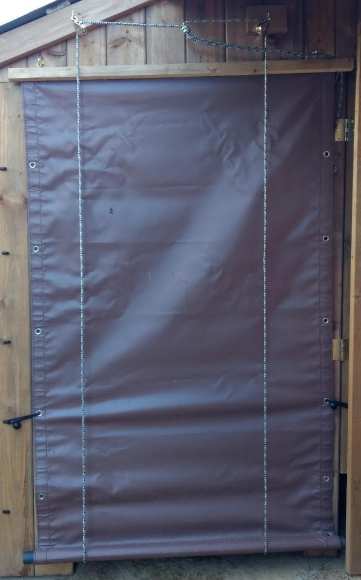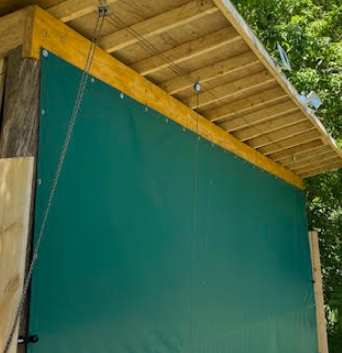 If you need a door for your shed, barn or garage, consider making a roll-up door using heavy duty vinyl. These will last for years and will cost a fraction of the price of a metal or wood door.
If you need a door for your shed, barn or garage, consider making a roll-up door using heavy duty vinyl. These will last for years and will cost a fraction of the price of a metal or wood door.
Vinyl doors are great for keeping snow and rain out and for use as a windbreak.
In this picture we show a door that we constructed with zippers running vertically near the outside of the tarp. This allows the tarp grommets to be used to secure the tarp to the frame of the shed or barn while still allowing quick and easy access. If you just want to walk through the doorway, you only need to partially unzip one side.
 When you need to get equipment in or out you can unzip both sides and roll up the door as shown here. Ropes are wrapped vertically under the door so that it can be secured in any position, just by tensioning the ropes. In the photo near the bottom of the page we show another example of a roll-up door which does not use zippers.
When you need to get equipment in or out you can unzip both sides and roll up the door as shown here. Ropes are wrapped vertically under the door so that it can be secured in any position, just by tensioning the ropes. In the photo near the bottom of the page we show another example of a roll-up door which does not use zippers.
Heavy duty vinyl comes in a wide variety of colors so you can usually choose something that will blend well with your building.
A door will also help to keep rats, skunks and other unwanted "guests" out of your utility shed or barn.
Before ordering a roll-up door, there are a few things you should consider.
- How will you secure the tarp door to your frame?
We will typically put grommets around the perimeter (edges) of the tarp. Our standard spacing on these is 24" apart however this can be adjusted to fit your needs. Other fastener options include D-Rings, Marine Snaps and Common Sense Fasteners.
- How wide should the tarp be?
When using standard grommets, decide where the grommets will be anchored/screwed to your opening on either side then measure the distance center-to-center between anchors on the left and right side. This is where your grommets should be; add 2" to this distance to determine the tarp width.
- How high should the tarp be?
When using standard grommets, decide where the grommets will be anchored to the top of your opening then add 1" to this to determine the height of the tarp.
- Will you need zippers?
Zippers allow you to open the tarp partially and make it easy to roll the tarp up/down without unfastening the grommet anchors. If you plan to add zippers you will need to determine how far in (from the outer edges of the tarp) the zippers should be placed. Also, decide how long the zipper should be.

- Will you need a pocket/sleeve at the bottom of the tarp?
Pockets are typically used to insert a weighted rod or pipe to keep the tarp down and also to help with rolling up. Some people opt to use grommets instead so that they can bolt a bar or large dowel onto the bottom. A PVC pipe filled with sand (with caps for the ends) can be used. This has the advantage that you can add/remove sand to calibrate the weight. If it's too heavy or too light it will not roll up well. If you are adding a pocket, decide what you will be putting into the pocket as a weight. The diameter of this will determine the size of the pocket.
The most common configurations for rollup tarps are:
When determining the height of your door it is a good idea to keep the bottom of the tarp slightly off the ground. This will prevent wear that would occur if the tarp is dragged across gravel, etc. due to blowing winds. Also, this would prevent the tarp from freezing to the ground in cold climates.
Keep in mind that we don't supply the roll-up mechanism, only the tarp itself. The parts needed to build the roll-up hardware are readily available from most hardware and building supply stores. For a parts list and installation instructions we recommend using readily available guides and tutorials that can be found online. One such overview video can be found here: designing a roll up mechanism.
 Roll up doors don't have to be overly complicated.
Roll up doors don't have to be overly complicated.
Here is a simple roll up door mechanism sent to us by one of our customers.
Here is a close up of the two simple pulleys above the door.


 Received the tarp and it has exceeded expectations especially for the price. Using it for my large ATV/Riding lawnmower and firewood garage as a retractable door in a pulley system. The tarp is of great and durable quality and made to perfection to my requested dimensions. Well done! Would recommend to anyone looking for heavy duty tarps that are durable.
Received the tarp and it has exceeded expectations especially for the price. Using it for my large ATV/Riding lawnmower and firewood garage as a retractable door in a pulley system. The tarp is of great and durable quality and made to perfection to my requested dimensions. Well done! Would recommend to anyone looking for heavy duty tarps that are durable.
 We now have both my doors installed. I must say they work great. Fit was right on so no issues. Compared to the heavy tarps loaded with metal bars and wire rope these new roll ups are so simple to use. Here are some pics, we used a 4" abs pipe in the pocket to assist in the rolling of the tarp. My crew and myself send a big thanks for helping us out.
We now have both my doors installed. I must say they work great. Fit was right on so no issues. Compared to the heavy tarps loaded with metal bars and wire rope these new roll ups are so simple to use. Here are some pics, we used a 4" abs pipe in the pocket to assist in the rolling of the tarp. My crew and myself send a big thanks for helping us out.